Old grapes, new painting
November 18th, 2006
A drawing on paper (click image to enlarge):
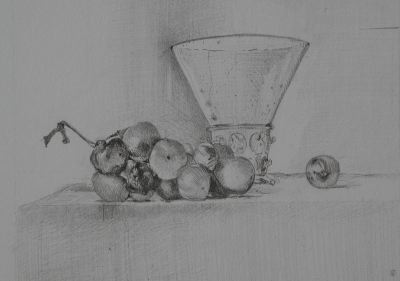
. . .
Underdrawing on panel:
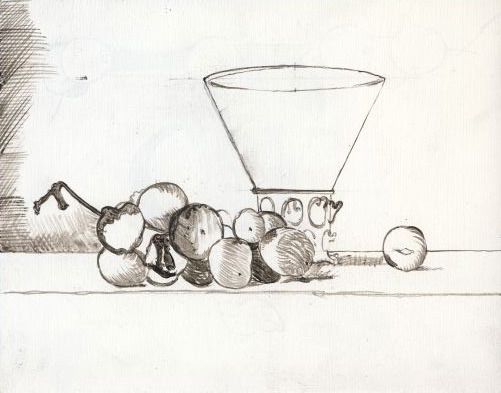
. . .
Underpainting with acrylic:
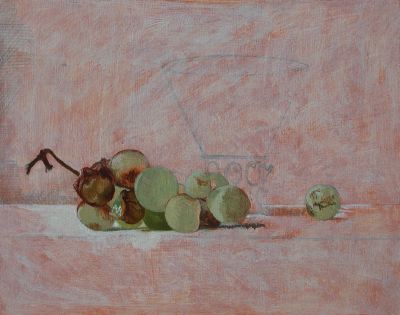
. . .
Overpainting with oil:
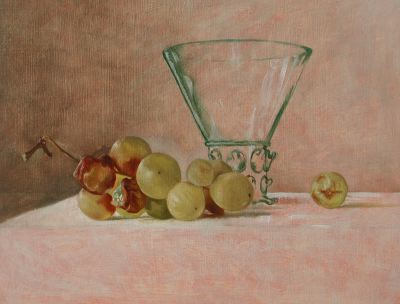
. . .
Overpainting with oil, second day (click image to enlarge):
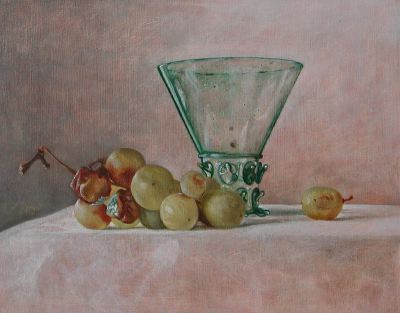
. . .
Comments?
. . .
November 18th, 2006 at 6:14 am
I love the pink in the background.
November 18th, 2006 at 6:38 am
I seem to be looking down on the grapes and up at the glass.
I can’t reconcile that with the overall style of the painting.
The colour set and the details are appealing.
November 18th, 2006 at 7:40 am
Dear Hanneke,
You seem to have a very sophisticated process of painting and the results are working very well for you…
The subject matter you seem to choose is always very good, as even the rotten grapes you can still make them visually attractive…
November 18th, 2006 at 10:18 am
Colin, I know it might seem off, but if the point of view is from very close, and the center of the glass is at eye level, then I think we would be looking slightly down at some of the grapes and up at the rim of the glass.
November 18th, 2006 at 11:06 am
David, I was just about to write what you wrote. The viewpoint is close (I was at the studio yesterday and I saw this); the top of the glass is seen from below, the bottom is seen from above (slightly), as with the grapes.
November 18th, 2006 at 11:10 am
even the rotten grapes — you can still make them visually attractive
Angela, what do you mean by “attractive.” I find the mold pretty disgusting myself, and the skill with which it is rendered only increases my feeling of revulsion. I think Hanneke is going a bit over the edge of “tasteful” still life here. Maybe that is good, but who is going to pay for it?
I love the pink in the background.
Birgit, you seem to be saying the same thing I am, in a more diplomatic way.
November 18th, 2006 at 11:14 am
David/Karl: I don’t want to make a great point of this. I was just reacting. In my terms some of the perspective is using a 20mm lens and some of it uses a 90mm lens. Nothing is wrong. It is just a reaction.
November 18th, 2006 at 11:16 am
Here is part of an off-line discussion I’m having with Hanneke . . .
(The Dutch have a thing about poop that is baffling to foreigners.)
November 18th, 2006 at 11:46 am
even the rotten grapes — you can still make them visually attractive
Dear Karl Zipser and Hanneke, what I mean is that even the fruit is rotten is still beautifully painted…
Many surrealists have painted chaotic and repulsive subjects that can still be admired as extraordinary stunning pieces of art!
All the best!
X
Ps I don’t mind the poop; there is some fascination about it…
November 18th, 2006 at 12:51 pm
It is difficult to tell from the small pictures, but my own preference is for the initial drawing on paper and the underpainting with acrylic attracts me too. They both strike me as the result of a lively hand and eye. The overpainted oil strikes me as the result of an exercise. But then I am criticising what I could not achieve myself, and from a point of view which does not generally go a bundle on contemporary very representational paintings.
I sound very negative; but in the final piece I do very much like the colour juxtaposition of the background and the grape tones (except the rotten ones which for me do not work).
November 18th, 2006 at 12:54 pm
I love the moldy grapes! I used to keep banana peels on my dashboard because their black twisted forms were very beautiful to me! Isn’t rotting food a whole tradition in Dutch vanitas painting in particular? To comment on the ephemeral quality of life?
And Karl, is the point of these paintings to sell them? Sorry if you have covered that territory as I am new to the blog. I agree that people who want a painting of grapes in their kitchen may not care for the moldy ones. But others will delight in their decay. I know I do. The honesty and melancholy of them attracts me. I have a series of paintings of chewed gum. I also understand the poop thing. Maybe I have Dutch blood?
November 18th, 2006 at 3:33 pm
Leslie,
Hanneke has an exhibition of still life coming up at a gallery in Haarlem. Fortunately, she has many rot-free paintings to sell.
We are not selling work here on Art & Perception at the moment. To do so would be a big change in the nature of the site. We discussed the issue a bit earlier, then let it drop. To sell work here on a regular basis would I think require the consent of the other contributors. But if someone wants to try it as an experiment they are welcomed to do so, as far as I am concerned — speaking as just one of the contributors. We could see what happens. People might complain, or they might love it. I doubt the artwork would sell though. We have an artist audience, not a collector one (as far as I can tell). What do the rest of you think?
November 18th, 2006 at 3:36 pm
Omega,
You can click on the drawing on paper and last painting image to enlarge. Hanneke has a special gift with drawing, I agree with you.
November 18th, 2006 at 3:48 pm
Leslie,
Haarlem was a major center for vanitas still-life. The image in the link is an example of a painting by 17th c. Haarlem artist Pieter Claesz.
Hanneke’s painting certainly has some of the formal compositional elements of a vanitas still life. However, the vanitas genre has a symbolic meaning meant to evoke “the transience of life, the futility of pleasure and the certainty of death”. Hanneke is enjoying playing the cello at the moment. I interrupted her to ask her if this was her purpose in making her painting. She said:
“No. I took the fruit out of the glass [where it had been sitting since she painted the last picture] and I thought ‘This is amazing. I want to paint this.’ It was only later that I thought about the meaning.”
When I asked her if she thinks the painting is intended to “encourage a sombre would view” (a key characteristic of vanitas still life) she said “No” and went back to playing her music.
November 18th, 2006 at 7:04 pm
Hanneke – I spent a lot of time looking at the first grapes in glass as I used the image to make sure the colors I selected for this site didn’t interfere with the art work. It took a while to realize it but the glass in that first piece does not cast much of a shadow in the final version (it is there in most of the previous versions). I think this is one reason I get a feeling of coldness from that work (it’s not just the colors). The glass doesn’t feel quite real to me, which is very different from the grape on the table which is very luscious in that painting.
Anyway now that I see this one is casting a shadow I can put this into words better. I don’t have much experience evaluating representational artwork but it has been fascinating to see your paintings in progress.
November 18th, 2006 at 7:08 pm
Karl – you said:
Maybe that is good, but who is going to pay for it?
So Leslie asked:
is the point of these paintings to sell them?
I don’t think you answered her question – or maybe you did. But I don’t care about selling on this site and I have the same question.
I want to know why you said “who is going to pay for it?” – is that the only reason Hanneke paints – to sell? Is there never any other reason to paint? If there are other reasons to paint then why ask that question in the first place?
I’m curious what Hanneke has to say about it – did she paint this only to sell it or was there other motivation?
November 18th, 2006 at 8:06 pm
Lisa,
of course I did not paint them for the sake of selling I didn’t sell those grapes yet. I would like to keep them for a future exhibition so that I have a nice collection to show. And than sell.
November 19th, 2006 at 3:40 am
Lisa, you said/asked:
I want to know why you said “who is going to pay for it?” – is that the only reason Hanneke paints – to sell?
I think the correct response is that the only way Hanneke is going to be able to paint is if she sells. If she can paint from her heart and sell, good for her. That seems to be what she is doing here with her moldy grapes — painting from her heart. Leslie likes them, but Leslie is not an art collector.
If Hanneke needs to adjust her message in order to survive as an artist, then she will do that, or she will have to find another full time job. That is economic reality. I hope she succeeds with her art, one way or anther, because she doesn’t have the skills you do in computer programming. Her non-art job might be something quite uninteresting.
November 19th, 2006 at 4:52 am
Karl,
Despite Hanneke’s intents, her work refers to the vanitas still life tradition in several ways. I don’t think you can paint rotting grapes in her naturalistic style without referring to that history. She may not have intended the grapes to be somber, but their rotting is not exactly cheery is it? I am just being playful with your careful dissection of her connection to the vanitas tradition here…
“If she can paint from her heart and sell, good for her” I have had plenty of non-art jobs, both interesting and uninteresting that support my art making. Sometimes the ones that are interesting are TOO interesting and take my energy away from the art. So an uninteresting “day job” can sometimes free up energy and time and make it an economic possibliity to “paint from the heart”. If I couldn’t mostly paint from the heart, I am not sure if I would do it.
November 19th, 2006 at 7:58 am
I was only alerted to the moldy grapes by reading comments. Sitting in an internet cafe, quickly scanning mail and artandperception, I was delighted at the combination of pink background and green glass. Not liking black as a color, I am happy that Hanneke has forsaken her black backgrounds. Perhaps, I did not focus in on the mold because as an outdoor person and biologist, I don’t find moldly grapes so terribly weird.
November 19th, 2006 at 11:08 am
Leslie, good point about the rotting grapes. I agree with you, of course. That’s why I was interested in Hanneke’s interpretation.
Birgit, sorry about misinterpreting your comment!
November 19th, 2006 at 9:18 pm
I just wanted to note I really appreciate it when you post from the begining of a piece. I have learned more from seeing you guys then I ever realized I would. For someone who has never had the opportunity to study with a proffesional this is a wonderful opportunity to see how some things are done!!!
As for the grapes.. I like what it adds to the painting it makes it unique and it reminds us that not everything in life is perfect. It comes with good and bad. If I could afford it, it is something I would buy just because it does remind one of that. I love the glass and how you painted the colors. It is a beatiful piece.
November 19th, 2006 at 11:37 pm
I think the correct response is that the only way Hanneke is going to be able to paint is if she sells.
But does a painter have to sell every single painting? Is there never room for growth and learning in a direction that is possibly not marketable – or are such efforts just a waste of time if you need cash?
November 20th, 2006 at 7:54 am
Wolfbaby,
this is a very meaningfull comment for me . I didn,t understand the meaning of the rotten grapes yet The painting gives a vey wise lesson to the painter and I shoul not sell the painting just to remind me of that.
Thanks a lot
November 20th, 2006 at 10:09 pm
There is a great tradition in “Still Life” to paint dead and dying things, As I’m sure most painters know, the French refer to it as Nature Morte. “Dead life.” What is the Dutch phrase?
I have seen a lot of edgier stuff that transcends the merely decorative and speaks directly about the fleeting and ephemeral nature of life. There will always be collectors who understand this and will gladly pay extra for a more transcendent piece.
Carry on Hanneke. Carry on. Your work becomes more valuable still, for now you talk about life itself.
November 21st, 2006 at 3:35 pm
Hey Sis!
Still love your work. If only I could put up my scriblings up here!
Greetzzz …
November 22nd, 2006 at 9:23 am
Hey Frank, nice of you to stop by. What kind of “scriblings” do you have in mind?